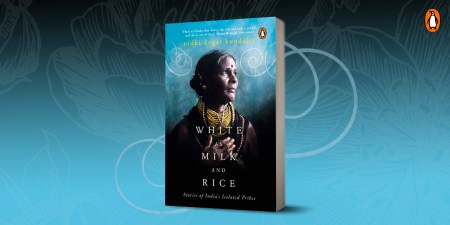
Inhabiting the remote hills and forests of India are isolated communities of people who have survived the ever increasing influence of urbanisation. The Adivasis have their own religious beliefs, traditions and rituals which are far removed from the rest of the country. White As Milk And Rice takes us away from our metropolitan cultural medley and leads us into life stories from six remarkable tribes of India where we see age old traditions manifest in the rapidly changing milieu of their fragile world.
Read on for a glimpse into the traditions of the Adivasis from the stories in White As Milk And Rice –
The Halakkis of Karnataka
The Halakkis’s janapada, or folk songs, are passed on from one generation to another as part of their oral history. These folk songs are sung by the Halakki women, unaccompanied by instruments, as they go about their daily chores. With no formal knowledge of music, the women sing in the same tune ,mostly out of habit, as an expression of joy, sadness, anxiety or contentment.
‘Why did they all know the chorus to these songs? Sukri wonders. They had inherited these songs orally, rather than in written form. Often, the meaning of the colloquial, ancient words escapes them, but they sing it for the sorority—songs that bind them together through their hardships, but songs Sukri associates only with happiness, with festivals, forests, family, weddings, weeding, working on paddy fields.’
The Kanjars of Chambal,Rajasthan
Originally a community of valorous Rajputs, the Bhatus were pushed to the margins of society by multiple invasions in the Indian subcontinent. Of the many Bhati Rajputs that fled into the jungles, some styled themselves as rebels or baghis who operated out of the labyrinthine ravines around Chambal river and came to be known as Kanjars. The Kanjars performed a much revered ritual before leaving for heists –
‘The night before, Lala had taken out a silver bowl from one of the bundles in his sikri, brought the empty bowl to his lips and kissed it, closing his eyes, holding his breath as if tasting the tenacity of his ancestors. Later, his wife had poured in kaccha khatiya and some goat blood into the bowl. Sipping on it, Lala had given an oath or a pledge of loyalty to the gang and acceptance of the consequences if a breach of trust was made.’
The Kurumbas of the Nilgiris, Tamil Nadu
Descendants of the Pallava dynasty of southern India, the forest-dwelling Kurumbas are regarded as some of the oldest inhabitants of the Indian subcontinent. Scattered in the hills around the Nilgiris, the Kurumbas are believed to possess extraordinary spiritual and supernatural powers. Most Kurumbas survive by selling forest produce and the honey-gathering season is celebrated with ceremony-
‘Old grandmothers of the hamlet would sing songs in the village square about honey collection; interspersed would be songs on elopement with lovers, extramarital affairs, abnormal sex organs, jackfruits, cucumbers, etc. The men would have played tamabati, or the drum, to which the younger women would dance in circles, clapping their hands together below the waist. ‘
The Marias of Bastar, Chattisgarh
In the Gond society, Ghotul is a tradition that is integral to the Marias socio-religious beliefs. The nightly ritual is announced with the beating of drums and a procession of young boys and girls heads to the ghotul which could be described as a clubhouse. Dressed to please, the young Marias sharpen their seduction skills while enjoying music, dance, games and massages. Most activities are designed to develop intimacy between the sexes.
‘In this soft, diffused glow of affection, boys and girls lived together in that dormitory for years; a charming mixture of learning and experimenting with lovemaking, none of it meant to be taken seriously.’
The Khasis of Shillong, Meghalaya
Being a devout Khasi entails a life of discipline and familial duty. In old-fashioned Khasi families the birth of a female child is celebrated with a feast. Learning to keep a home, performing ancestral worship and looking after family members is part of induction to life as a Khasi female.
‘The Khasis follow the matrilineal principle of descent, residence and inheritance. The youngest daughter inherits, children take their mother’s surname, and once married, the khadduh, or the youngest sister, and her husband live in her mother’s home.’
The Konyaks of Nagaland
Straddling the Indo-Myanmar border, the fiercely independent Konyaks are believed to be followers of an indigenous animist religion. Young men in the tribe practise war skills and their training is focused on preparing them for life as warriors. The tribe’s collection of severed enemy- heads is their pride.
‘A “good naomei” protected his comrades and never refused a beautiful woman’s advances. Our village must grow bigger, stronger and for that, enemies’ heads must be secured, brought to the village and fed rice beer. This would bring it prosperity and for the naomei, some virility. The more the heads, the more the reverence.’
Nidhi Dugar Kundalia takes us into the remote regions of India where tribal communities practice and preserve their traditions with reverence even as external forces make inroads into their precariously balanced existence.
To know more about the original inhabitants of India, read White As Milk And Rice!









